Son of the White Mare (1981)
Directed by: Marcell Jankovics
Written by: László György, Marcell Jankovics
Starring: Ferenc Szalma, Gyula Szabó, György Cserhalmi, Vera Pap
AKA FEHERLOFIA
HUNGARY
AVAILABLE ON BLU-RAY: NOW, from EUREKA ENTERTAINMENT
RUNNING TIME: 87 mins
REVIEWED BY: Dr Lenera

The world has fallen on hard times. It was once ruled by the Forefather and things were good, but then his three sons all got married and their wives freed three powerful dragons who brought darkness upon the land, with the Forefather losing his life. Nearby, a mare gives birth to three sons who become human as soon as they leave the womb. Two of them leave their mother but the third, Treeshaker, remains with her for many years until he’s gained a huge amount of strength. After his mother dies, he also leaves, setting off for the underworld to rescue the princesses and slay the dragons. Along the way, he runs into his brothers Stonecrumble and Ironrubber, and after some initial confronting of each other they team up for the mission….
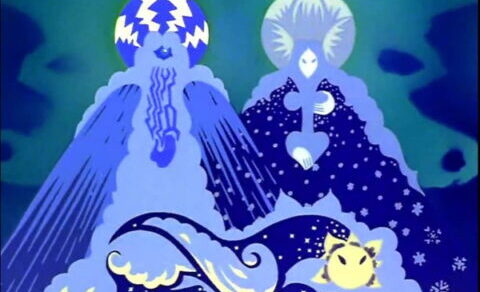
Disney’s Fantasia and Alice In Wonderland, flops upon their original releases in 1940 and 1951 respectively, found new and very appreciative audiences in the late 1960’s, when their trippy visuals were just what a large sector of the population wanted, either providing journeys without the need for drugs or considerably enhancing a voyage further. The animators must have been on LSD [which would actually have made it virtually impossible for them to carry out their painstaking work but never mind] or at least heavily inspired by their journeys, many thought. Of course that wasn’t true. Well, here comes an animated movie which seemed to Yours Truly to have been even more inspired by the consumption of naughty substances. Yes, the Doc admits he has dabbled, and he can therefore say without hesitation that Marcell Jankovics’ extraordinary film is probably as close to the experience of having a full-on psychedelic experience as the cinema can give us. It seems to just totally get it, from the colour patterns, to the frequent transforming, to the very texture. Yet – and I’m writing the main part of this review before I’ve watched any of the special features on Eureka’s Blu-ray release [of a film I sadly hadn’t even heard of before it dropped through my letter box] so will correct myself later if I’m wrong – I wouldn’t be surprised if, as with the Disney films, any drug connection was unintended. Jankovics may well be rather annoyed at me if he was still alive and happened to read this review. But the first and most obvious thing to state is, yes, this film is there. It will give you give you non-dabblers a real sense of what an acid or mushroom trip is, it will provide you naughty users with flashbacks, and it may be a perfect thing for some to accompany trips though personally I think it’s better to keep the two things separate. I find totally zoning out to a movie with no stronger accompaniment than a cup of tea [and no, not with anything else in it] to be where it’s at in terms of movie watching.
I felt it was important to go into that a little, but we’ve now got that out of the way. I’m sure you realise by now that visually this is something quite incredible, though I’ll also say right here that the first few minutes are so startling – there’s no gentle introduction here, we’re just thrown immediately into the craziness – that some viewers may find it hard to take, though things do slow down a little [just a little!] once the main part of the plot begins. Especially peculiar to some may be that the characters don’t have black contour lines, so they seem more a part of an environment which, while containing more solid detail than the characters, is basically composed of borderless cells which undulate and transform into new cells. I suppose The Yellow Submarine might be a good point of reference in terms of look, but ramped up to ten. The credits tell us that Son Of The White Mare is based on a Hungarian folk tale named Fehérlófia, though it seems that more than one creation myth has been borrowed from too. The story, which is essentially pretty simple though you may not think it for a while as you adjust to the bombardment of eye-popping imagery, contains archetypal situations, characters, symbols etc. which have turned up in a lot of myths and legends in variations, but never does this film feel like a random mix just thrown together; instead it feels like something very primal, something which takes us back to our distant past when we were full of wonder and couldn’t properly explain the things around us. The use of certain shapes and symbols is particularly interesting, a good example being the ying yang symbol, which crops us a few times in usually vague form, sometimes extremely fleetingly so we wonder if we really did see it again or were just imagining it.
We begin with jagged flashes of light against a black background form a white horse which then seems to go into something looking rather like the sun. Already, we’re given things to look at which make no sense from a logical perspective. We see the mare give birth to another horse, which also sometimes looks like a demon before it then changes into a human. Mother teaches child to walk and is also telling this story to her child inside a tree; what’s story [or flashback] and what’s current reality is a little vague here. Maybe a bit of clarification would have helped and certainly not harmed the integrity of the film, especially as most shots are surreal in some way, but Jankovics obviously isn’t a filmmaker to make things easy for the viewer to totally “get”. As the mother’s voice commences telling us about a terrible event, we see her walking round on the inside of a circle which has four ying yang symbols inside. Clearly we just need to accept much of what we see on metaphorical terms or as just a cool visual, which is fine if you’re able to get on a certain wavelength. We’re told about the Forefather who once ruled the land until his reign was ended when three evil dragons [who don’t look at all like dragons] who were freed by the three wives of the three sons of the Forefather. Why did the wives free the dragons? We’re not told. This is exactly the sort of plot question which in most films would irritate immensely and come across as very poor screenwriting. But in this one, it matters little. One feels that the reason may have been once known but has since been forgotten, despite the fact that it causes the kingdom to be destroyed in a bombardment of peculiar imagery which borders on being genuinely abstract, really blowing wide our conceptions of what we expect to see and understand in a movie. It’s truly incredible, if a little wearing if you’re not ready for it.
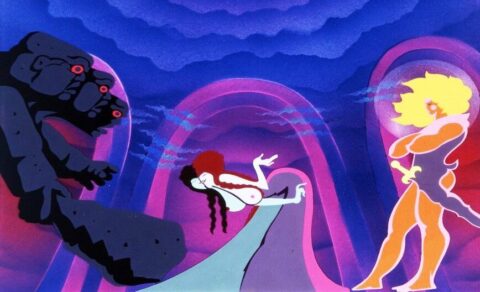
The mare has another child but in hiding because she’s not supposed to give birth anymore. Again, we’re not told why, it just is. The boy, soon to be known as Treeshaker, wants to lift up the mystical tree which exists inside a huge circle – so is this possibly the tree of life? – they’re living in, but is too young, and is told to be more patient by the ghost of a man Treeshaker calls grandfather though he’s not [is he his father, which really brings up some strange thoughts]. Many years later he’s an adult and lifting up the tree has become not just possible but easy. Mother sadly now dies. but beforee she does so she tells her son to “go to the underworld”. It’s not very clear until a few scenes later but what he has to do is rescue these princesses and destroy these dragons who’ve brought darkness to what seems to be the whole world. He comes across another man with whom he briefly wrestles; the vanquished guy says that not just will he just be his companion, but that he’s his long lost brother. This means that it’s little surprise when, after Treeshaker literally smashes through the mountains that are in his way, the third brother is also soon found. Treeshaker, Stonecrumble and Ironrubber [their superpowers are all basically super strength, as can be deduced by their names] all become friends, but bums are smacked when a mischievous gnome with “ a beard as long as a hoe” comes across the poor brother who’s been told to “make a rope and get lunch”, then the second, then the third. Indeed, as the journey progresses – the passage to the underworld being actually located under the tree – most of the situations revolve around each brother encountering the same situation or variations of the same situation, what’s really important being how they react. Treeshaker, for example, doesn’t immediately welcome the gnome with hostility like his brothers.
Some of what transpires is quite amusing, like the reaction of the third princess to the arrival of one of the brothers being so joltingly different from those of the first two. One of the former actually shows her breasts, though I wouldn’t say that this moment ought to prohibit kids from seeing the film – on the contrary, experiencing animation that isn’t Disney or Dreamworks or even American will expand and enrich their minds. After all, there’s very little violence, even of the bloodless kind. Combat usually takes the form of wrestling, and wrestling reduced to somebody trying to throw the other person. You could say that not enough is made of the battles between the brothers and the dragons which don’t possess the excitement that they probably should have, but then that’s clearly not what Jankovics was going for anyway. While a griffin, a snake and giants do sort of resemble the way we think they should, the dragons are a different kettle of fish. Their mechanical appearance suggests a dislike by Jankovic for the modern age, something that’s made very obvious by the otherwise very weird final scene where a giant Treeshaker walks by what looks like a city in black silhouette. This seems to me to be expressing a yearning for the values of old, in particular its sense of wonder, not to mention it being a time when true heroes existed – or people were told that they existed and they believed. Where are the heroes of today? Folk of real stature just don’t seem to exist nowadays, says this film, and I can’t help but agree even if the likes of Treeshaker, Heracles and Gilgamesh only existed in legends. This adds a poignancy to the enterprise even though it may not be immediately apparent, and the often amusing interplay between the three brothers provides a genuine and relatable human side to the proceedings even if it seems initially that providing the viewer with constant visual stimulation is what it’s all about.
The strangest visual conceit in a film full of strange visual conceits may vary from viewer to viewer, but for me one of them is the fact that people are constantly changing slightly, especially their faces and especially the faces of the princesses, perhaps or perhaps not symbolising the way that they’re thwarting the men’s expectations of them. And then there’s the way that journeying from place to place on the surface actually takes place on a big circle, as if the people are so huge that the Earth really is small to them, at least until they reach each destination. But then all the way throughout the film geography is skewed, while shapes and waves of colour are continually present and changing at a startling rate in an almost stream of consciousness fashion as scenes literally melt into each other. It really is incredible, though it’s dying out for a musical score. We have a variety of electronical sounds, but I couldn’t help but wonder how some great music would elevate the imagery even further. Then again, if you own a large music collection then I’m sure you’ll be able to play something suitable alongside the film next time. Even with just the sounds, Son Of The White Mare is an extraordinary experience. It makes one realise that, despite the undeniable high quality of much of Pixar’s output and the sheer fun factor provided by companies such as Dreamworks and Illumination, today’s computer animation still lacks the breadth of creativity, and perhaps even the soul, that handdrawn animation can provide.
Rating: 









SPECIAL FEATURES
Limited Edition O-Card slipcase
1080p presentation on Blu-ray from a director approved 4K digital restoration
This seems to be a direct port of the 2021 Region A release from Arbelos Films, with the same special features. The 4k restoration was done in 2019 by Arbelos themselves, but plans to release it in cinemas were scuppered due to Covid. I’d kill to see this film on the big screen, but on Blu-ray it still blew me away. The restoration definitely provides the very complex colour balancing required and you can make out so much intricate detail.
A collector’s booklet featuring a new essay by film writer Rich Johnson
EARLY WORKS
Johnny Corncob (János Vitéz) – Jankovics first animated feature, and the first ever Hungarian animated feature film, is also presented here in 1080p from a director approved 4K digital restoration [74 mins]
The special features kick off with a real treat; another feature length motion picture from Jankovics. This earlier work isn’t quite as insane as Son Of The White Mare but still contains many of its stylistic aspects. Its look, especially with regard to its characters, is much closer to Yellow Submarine yet there’s still a sense of pure freedom. Based on a poem by Sandor Petofi in 1888, it tells the story of a shepherd named Kukorica Jancsi who falls for the beautiful Illuska [PC types will bristle at the bit where he begins to drag her away from her room within minutes of meeting her] after hearing a female voice answering his flute playing, an act which somehow makes the valley in which they live bloom, as it also does when they first kiss which is a wonderful idea. However, the act of kissing her somehow causes his sheep to go into the sky, while she has a nasty witch of a stepmother. Jancsi has adventures with bandits then soldiers, then rescues a Russian lady. There’s another journey into an underworld and more bits of humour such as soldiers walking on ice having to carry their horses, while the valley also seems to exist in some sort of circle. Clearly Jankovics partly saw Son Of The White Mare as an opportunity to develop things that were in this film, but there are already many moments where things just appear and transition into other things that aren’t really do to with the story but which provide metaphorical weight which gets through to your subconscious. I’d love to write a full review of this also, but time prevents me right now. In the future I will though. It’s quite wonderful. David Lynch fans will spot an image that’s used several times in Wild At Heart.
Sisyphus – short film [2 mins]
The Greek legend of Sisyphus concerns a man who, once he dies and went to hell, was punished for his crimes by having to constantly push a boulder up a hill and never succeed. This is a black and white visualisation of that, but with a happy ending.
The Struggle (Küzdok) – short film [2 mins]
A sculptor is using a hammer and chistle on the statue he’s creating – and the statue fights back, doing pretty much the same to him. Clever and charming. Also in black and white.
Dreams on Wings – short film created as a commercial for Air IndiaBrighter Colors [8 mins]
This shows the developing style of Jankovics , with image effortlessly transforming into image as he uses the idea of an advertisement for an airline to give us a potted tour of the world. A leg of the Eiffel Tower becomes the Leaning Tower of Pisa. Ocean waves become the towers of Moscow. A great watch.
SPECIAL FEATURES
Bright Glass – extensive interview with Marcell Jankovics from the Hungarian National Film Archive, filmed in 2020 [37 mins]
This is an insightful interview with a man who is clearly some kind of genius in the world of animated film. Jankovics tells of how he wasn’t accepted at university for “political reasons” and didn’t even intend to be involvement in animation, but got into working for Pannonia Studios when somebody else wasn’t able to work on something and his boss recommended him because he drew well. He didn’t like it that “stories had to be infantile or humorous” and didn’t feel comfortable working in the two main animating styles of the time. He goes through his early work, providing some interesting facts; Johnny Corncob was bought by Hanna-Barbera but, after changing the music they didn’t release it, Sisyphus was inspired by his struggle to make Johnny Corncob, while Jankovics never did drugs but was certainly aware of psychedelic art when he made Son Of The White Mare, its style actually inspired by dreams, he being once told by somebody that his son told him his dreams were just like it.
The Director Talks – featurette with Jankovics produced by the Hungarian National Film Archive [8 mins]
Much of what Jankovics says is the same is also in the above interview, but we do learn that his first draft for Son Of The White Mare was rejected by the communist authorities who wanted a something more conventional, and that it flopped in cinemas for two particular reasons.
Making of János Vitéz – archival featurette from 1973 [3 mins]
Black and white footage of Jankovic and the studio where the film was made.
Whether you’re a serious fan of animation or just want to get “out of it” without the need for any dodgy goings-ons, “Son Of The White Mare” is a must. Eureka’s release is also a fine tribute to a filmmaker I didn’t know existed until now, but who is somebody whose work I want to explore further. Highly Recommended!


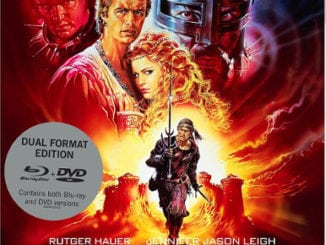
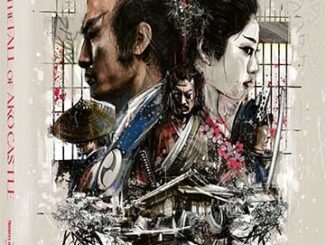
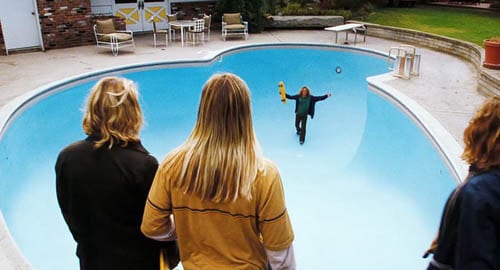
Be the first to comment